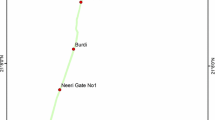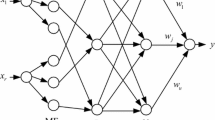Abstract
Optimizing the traffic signal control has an essential impact on intersections efficiency in urban transportation. This paper presents a two-stage method for intersection signal timing control. First, the traffic volume is predicted using a neuro-fuzzy network called Adaptive neuro-fuzzy inference system (ANFIS). The inputs of this network include two-dimensional, hourly and daily, traffic volume correlations. In the second stage, appropriate signal cycle and optimized timing of each phase of the signal are estimated using a combination of Self Organizing and Hopfield neural networks. The energy function of the Hopfield network is based on a traffic model derived by queuing analysis. The performance of the proposed method has been evaluated for real data. The two-dimensional correlation presents superior performance compared to hourly traffic correlation. The evaluation of proposed overall method shows considerable intersection throughput improvement comparing to the results taken form Synchro software.







Similar content being viewed by others
References
Niittymaki J (2001) General fuzzy rule base for isolated traffic signal control. J Transp Plann Technol 24(3):227–247
Henry JJ, Farges JL, Gallego JL (1998) Neuro-fuzzy techniques for traffic control. In: Proceedings of the 8th IFAC/IFIP/IFORS symposium on transportation systems, vol 2, Chania, Greece, pp 719–724
Lilin Z, Lei J, Luo Y (2006) An intelligent control method for urban traffic signal based on fuzzy neural network. In: Proceedings of the 6th world congress on intelligent control and automation, Dalian, China, pp 3430–3434
Maghrebi F (1998) On a Hopfield net arising in the modelling and control of over-saturated signalized intersections. Neural Process Lett 10(3):161–169
Wei W, Wang MJ (2003) Fuzzy-MOGA-based traffic signal control at intersection. In: Proceedings of the 2nd international conference on machine learning and cybernetics, pp 639–644
Dipti S, Chee CM, Cheu RL (2006) Neural networks for real-time traffic signal control. IEEE Trans Intell Transp Syst 7(3):261–272
Teodorovic D, Varadarajan V, Jovan P, Chinnaswamy M, Sharath R (2006) Dynamic programming—neural network real-time traffic adaptive signal control algorithm. Ann Oper Res 143(1):123–131
Nishikawa I, Sakakibara K, Iritai T (2005) 2 Types of complex-valued hopfield networks and the application to a traffic signal control. Proceedings of international joint conference on neural networks, Montreal, Canada, pp 782–787
Ning Z, Pitu M (2005) Analyses of vehicular delays and queues at intersections with adaptive and fixed timing control strategies. Proceedings of the 8th international IEEE conference on intelligent transportation systems, Vienna, Austria, pp 97–102
Yu XH (2005) An integrated model for signalized traffic intersection control. Proceedings of the 2005 IEEE conference on control applications Toronto, Canada, pp 1427–1430
Innamaa S (2000) Short-term prediction of traffic situation using mlp-neural networks. Proceedings of the 7th world congress on intelligent transport systems, Turin, Italy, pp 6–9
Annunziato M, Bertini I, Pannicelli A, Pizzuti S (2003) Evolutionary feed-forward neural networks for traffic prediction. International congress on evolutionary methods for design, optimization and control (EUROGEN), Barcelona, Spain, pp 17–20
Yasdi R (1999) Prediction of road traffic using a neural network approach. Neural Comput Appl 8:135–142
Yin H, Wong Sc, Xu J,Wong CK (2002) Urban traffic flow prediction using a fuzzy neural approach. Transp Res Part C: Emerg Technol 10(2):85–98
Dharia A, Adeli H (2003) Neural network model for rapid forecasting of freeway link travel time. Eng Appl Art Intell 16(7):607–613
Tong HY, Hung WT (2002) Neural network modeling of vehicle discharge headway at signalized intersection: model descriptions and results. Transp Res Part A: Policy Practice 36:17–40
Qiao F, Yi P, Yang H, Devaradonda S (2002) Fuzzy logic based intersection delay estimation. J Math Comput Modell 36(11):11–13
Ishak S, M. SCE, Alecsandru C (2004) Optimizing traffic prediction performance of neural networks under various topological, input, and traffic condition settings. J Transp Eng 130(4):452–465
LuC, Wei W, Tan Y (2004) Traffic variable estimation and traffic signal control based on soft computation. IEEE intelligent transportation systems conference, USA, pp 1045–1050
Takagi H (1988) Queuing analysis of polling models. ACM Comput Sur 20(1):5–28
Chee HN (1996) Queueing modeling fundamentals. Wiley, New York
Shing J, Jang JR (1993) ANFIS: adaptive-neural-based fuzzy inference system. IEEE Trans Syst Man Cybern 23:665–685
Castellano G, Fanelli AM (2000) A self-organizing neural fuzzy inference network. IEEE-INNS-ENNS Int Joint Conference on Neural Networks (IJCNN’00) 5:14–19
Freeman A (1991) Neural network, algorithms, applications and programming techniques. Addison Wesley, Reading
Wasserman P (1989) Neural computing; theory and practice. New York. Van Nostrand
Author information
Authors and Affiliations
Corresponding author
Rights and permissions
About this article
Cite this article
Kaedi, M., Movahhedinia, N. & Jamshidi, K. Traffic signal timing using two-dimensional correlation, neuro-fuzzy and queuing based neural networks. Neural Comput & Applic 17, 193–200 (2008). https://doi.org/10.1007/s00521-007-0094-x
Received:
Accepted:
Published:
Issue Date:
DOI: https://doi.org/10.1007/s00521-007-0094-x




